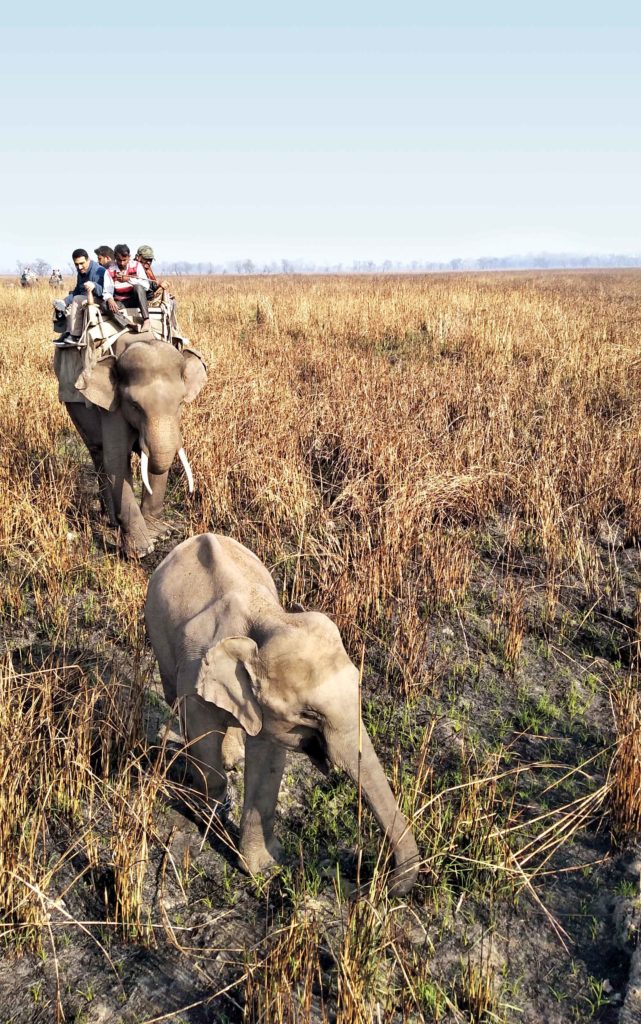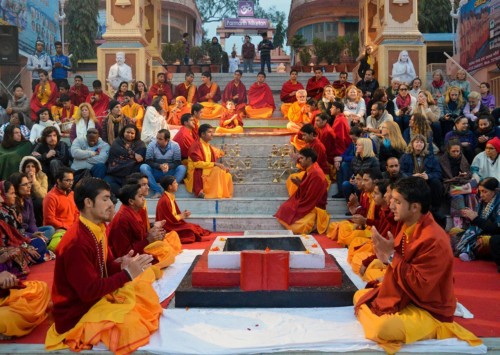Experience wilderness with a difference at Dudhwa National Park
India & You
January-February 2019

Rhino spotting from atop an elephant at Dudhwa National Park
Navigate the pristine forests in the Terai region of Uttar Pradesh for undisturbed wildlife and a unique taste of rustic India.
They say, there is nothing more frightening and exciting as getting lost in a forest. A deep, dense jungle introduces you to a whole new world. If you’re looking forward to an immersive and stimulating experience in the less-explored forests of India, consider spending a week in the Terai region of Uttar Pradesh. Surrounded by acres of litchi farms and sprawling sugarcane and wheat plantations, Jaagir Lodge, situated in the Lakhimpur Kheri district, on the border with Nepal and about 425 km from New Delhi, is your home away from home.
With its white-washed elegance of a colonial house, antique furniture and a space dedicated to wildlife books and manuals, it makes for an ideal place to escape the chaos and cacophony of the city life. Opt for their luxury rooms boasting of hand-crafted elements and wildlife-inspired furnishings or spend those pleasant nights in brick villas that are standalone buildings designed in the Terai architectural style. You’re transported to the splendidness of the Terai habitat from the very moment you enter Jaagir Lodge! Be in close proximity to spectacular wildlife during the day and relax and reflect on your rare encounters at the rustic lodge post sunset!
Into the wilderness
When in the Terai, make sure to devote an entire day to the picturesque Katarniaghat Wildlife Sanctuary, a sprawling 400 sq km park that demarcates India’s border with Nepal. Covered with dense and tall grasslands, along with sal and teak forests as well as wetlands, the santuary is largely untouched and retains its natural character. This hidden gem of the Terai offers an exquisite boat ride as well as a jeep safari to enable nature enthusiasts spot its myriad endangered species. The highlight of the trip is the 45-minute boat ride on the Gairwa river; a magical experience indeed!

From Left to right: Eurasian griffon, Flameback woodpecker, Fulvous whistling duck
Unpolluted and clear emerald waters, lush-green over-hanging trees creating coves, gharials (one of the three species of the crocodilian family found in India) resting on little islands, brown-roofed turtles striking a pose, frolicking freshwater dolphins and the skimmer flaunting its signature move of dragging the lower bill through the water – all effortlessly come together to weave a unique Jungle Book like experience. The jeep safari is a chance to soak in uninterrupted grassland views while photographing tribes of monkeys, peacocks, various species of deer, vultures, and crested serpent eagles.
Be watchful at all times as Katarniaghat also shelters many from the cat family including tigers, leopards, and fishing cats.
They say each forest has its own personality, feel, sounds, rustling whispers and smells. Curious to uncover these aspects in the Terai? Start at dawn to catch the first rays of sun as you enter Dudhwa National Park. Nestled amid warm, sub-tropical forests between the Himalayas and the plains of India, the 490 sq km park is a thick blanket of elephant grass with large patches of sal trees and wet marshes. Here, the only sound you hear is grunting and trumpeting of elephants, punctuated by soothing chirping of birds. Once the sun is out, it’s time to sit atop an elephant and set out in search for the regal one-horned rhinoceros, which was first re-introduced in the park under the Rhinoceros Conservation Programme, in exchange of elephants from Nepal. In the Terai, the high point of your adventure can be tracking the tiger, the most famous Indian feline, which can be spotted roaming around at the Kishanpur Wildlife Sanctuary, part of the Dudhwa Tiger Reserve near Mailani. Those moments of incredible tension experienced while tracing freshly-made pugmarks and finally being able to spot the big cat in the wild are unmatched and unforgettable. The thrill keeps you on the edge of the elephant-back seat at all times, with frequent rushes of the adrenalin as your hear the tiger’s roar or the monkeys screeching as they spot the tiger!
The reserve is also rich in avian life as numerous species of birds, unique to the reserve, can be spotted at the main water body, the Jhadi Tal. As you spend more time in the wilderness, you are likely to hear innumerable stories of Indian hunter turned convervationist Billy Arjan Singh, who loved tigers and fought to keep them alive in their natural habitat. Singh was the first to reintroduce tigers and leopards from captivity into the wild and his story will leave you feeling emotional, inspired and encouraged to protect and preserve wildlife.
Dedicate a day to the dense woodlands of Pilibhit. Covered with sal, teak, sheesham, banyan and mango trees, the reserve spreads across an area of 730 sq km. Spot four species of deer, as well as antelope, tigers, the Bengal florican, the great Indian hornbill and langur monkeys. On way, appreciate the rich flora and fauna of the region along the canals and bridges built during the British era.
A day with the Tharu tribe
There is a lot you can do here apart from navigating the pristine forest reserves that sit between the Himalayas and the great plains of India. To embrace the bucolic setting, walk along one of the many nature trails while spotting waders, kingfishers and other colourful birds and cycle on meandering pathways that run through sprawling farms on the periphery of Dudhwa National Park. All you can see is endless stretches of mustard yellow and lush green dotted with tiny villages; a vivid visual treat for a city dweller. Let the pure air, uninterrupted views and enchanting tranquility leave you intoxicated. On way, wave at smiling children, women adorning striking attire and indigenous jewellery, pagri-sporting men driving tractors and farmers humming regional songs while working in the fields. Locally, the region is known as ‘Mini Punjab’. And with justification! After all, Sikhs own 60 pc of its agricultural land and form more than 15 per cent of the population.
Going slow also gives you the opportunity to halt, meet and interact with friendly locals from one of the 40 villages around the park, and get to know all about their way of life. For centuries, the Tharu tribe has lived in close proximity to the jungle and their traditions reflect their intimate relationship with nature. While their origin isn’t clear, many locals believe that Tharus migrated from Thar Desert in Rajasthan, in the 13th to 15th centuries, when the Mughals invaded Chittor. The men stayed behind to fight the Mughals but the women and children fled east and settled in the forested Terai region. Upon knowing that all their men had been killed, they married the slaves who had attended them in their travels, and settled permanently in their new home.
Though their main occupation is farming, these tribals are renowned for their expert craftsmanship and impeccable hunting skills. The Tharus excel at the art of finding and training wild elephants, thus make good mahouts. For a deeper insight into the culture and customs of this prolific community, consider spending a day in an eco-friendly Tharu home, made out of mud, manure and straw and decorated with age-old motifs and tribal art. Learn to weave carpets and baskets from dried grass and savour regional cuisine prepared by Tharu women. Put a seal on another memorable day in rustic India with a dancing session. Young Tharu boys, trained in folk dance and music, often dress as women in colourful costumes and put up a traditional performance. To bring back some souvenirs, stroll through local markets where you can find a variety of fresh produce and other knick knacks.

From Left to right: Lesser whistling duck, Rhino crossing over a river, Pheasant-tailed jacana
Heaven for an avian enthusiast
While Dudhwa is home to an array of wildlife including mugger crocodiles and barasingha, or Swamp Deer, it is also a delightful oasis for an avid birdwatcher. With more than 400 species of birds, both resident and migratory, Dudhwa is as popular for its birds as it is for its tigers. The region’s remote location and the fact that it largely remains unexplored makes it an ideal location for birds as well. Scouring the landscape, you can chance upon species like the drongos, silver-bill munia, baya weaver, cattle egret, cinnamon bittern, falcons, kites, owls and pheasant-tailed jacana. The wetlands, marshes and swamps also provide prime habitat for many attractive birds like the pied kingfisher, flameback woodpecker, bitterns, the purple swamp-hen and the Eurasian thick-knee.
While green bee-eater, common coot, lesser whistling duck, parakeets, shikra, ferruginous pochard are some of the birds commonly found here, spotting crested serpent eagles and Eurasian griffon (vultures) requires time and patience. Devote a day to visit the banks of the River Sharda that receives annual migration of birds every winter. This is when thousands of barheaded geese, shell drakes, pochards and tufted ducks visit the flood plains, making it their breeding ground. Board a small canoe to admire these vivid birds from close quarters while taking in the diverse landscapes. A beautiful spectacle of nature!










